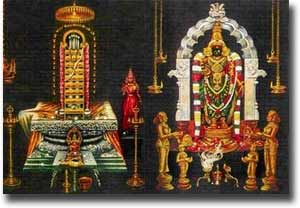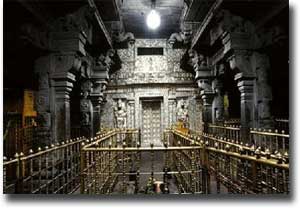 SriKalahasti temple is located 36 km away from Tirupathi in Chittoor district of Andhra Pradhesh, India. The inner temple is constructed around 5th century and the outer temple was constructed in the 12th Century. it occupies a place of eminence among the holy Siva kshetras. The temple is called as Dakshina Kailasam located on the banks of the river Swarnamukhi. The architecture of Srikalahasti Temple-Chitoor is extraordinary, it has three massive Gopurams which are breathtaking. Another striking feature of the temple is its huge Mantapam with hundred pillars.
SriKalahasti temple is located 36 km away from Tirupathi in Chittoor district of Andhra Pradhesh, India. The inner temple is constructed around 5th century and the outer temple was constructed in the 12th Century. it occupies a place of eminence among the holy Siva kshetras. The temple is called as Dakshina Kailasam located on the banks of the river Swarnamukhi. The architecture of Srikalahasti Temple-Chitoor is extraordinary, it has three massive Gopurams which are breathtaking. Another striking feature of the temple is its huge Mantapam with hundred pillars.
Srikalahasti is a holy town and a municipality near Tirupati, Chitoor District of Andhra Pradesh. It is located on the banks of the river Swarnamukhi. It is also informally and wrongly referred to as Kalahasti. It is a popular ancient Temple dedicated to Shiva and is one of the Pancha Bhoota Stalams (temples celebrating Shiva as the embodiment of the primary elements), air being the element in case here, the other five temples being Tiruvannamalai (Fire), Chidambaram (Space), Tiruvanaikkaval (Water) and Kanchipuram (Earth) respectively. Thousands of pilgrims from all over India visit the temple to have darshan of the almighty Sri Kalahasteeswara God and Goddesses Sri Gnanaprasunambika Devi.
This temple is also associated with Rahu and Ketu, (of the nine grahams or celestial bodies in the Indian astrological scheme). The Tamil Cholas and the Vijayanagara Rulers have made several endowments to this temple. Adi Sankara is said to have visited this temple and offered worship here. There are Chola inscriptions in this temple which date back to the 10th century CE. The deities worshiped in Srikalahasti Temple-Chitoor are Srikalahastiswara and his spouse Gnanaprasunambika. The Chola rulers constructed the main temple. In 11th century A.D., the Chola king Kuluthungal built the Caligopuram. While in the 12th century AD Veeranarashimha Yadavaraya contributed to the construction of the temple by constructing the compound wall or Prakara and the four Gopurams. In 1516 A. D., the great Chola king Krishnadevaraya built the huge 100- pillared Mandapa. The inscriptions on the temple inform that it was built by the great Pallava kings and folowed by the Tondaman Chakravarthi (Pandyam Kings).
One of the major festivals celebrated in Srikalahasti Temple-Chitoor is Mahashivratri, celebrated in the month of February and March for 10 days. The Shiva Linga of Srikalahasti Temple is considered to be one of the five important Lingas. According to Hindu mythology the five lingas represent the five great elements namely - Water, Fire, Ether, Air and Earth,established in the five great 'Kshetras'. At Srikalahasti Temple, Lord Shiva is worshiped as Vayu Linga of the wind God. A flame present in the Garbhagraha of the temple flickers even though no wind can enter the shrine. The skilful Yadav architecture of the temple indicates the presence of a shaft of wind near the deity and hence the fire in the lamp flickers.
Srikalahasti derives its name from His ardent devotees
1. Spider called Sri
2. Serpent called Kala
3. Elephant called Hasti

Temple Legend
According to Hindu mythology, the elephant or Hasti used to clean the Shiva deity by watering the idol with the help of river-water carried in his trunks and pray for him by placing Bilva leaves. The spider or Sri tried to protect the deity from external damage by weaving his web and to provide shelter for the Shiva lingam. The snake or Kala used to place its precious gem on the linga to adorn the lord. In this way, they all worshipped the Vayu linga separately without knowing what the other was doing.
One day, the spider had built a very big and thick web around the deity to protect it from dust and weather while the snake places its gem. The elephant not knowing this and assuming that this form of puja by Sri and Kala is a desecration by the seeming miscreants, pours water on it and cleans it up. This causes a fight between the three. The snake punishes the elephant by entering its trunk and in the process kills itself while the elephant runs amok and hits its trunk and head against the shiva linga. During this struggle, the spider is squashed against the linga by the elephant's trunk and the elephant dies due to the snake's poison. Lord Shiva then appeared and gave moksha to all three of them for their selfless devotion. The spider takes rebirth as a great king while the elephant and the snake reaches heaven for satisfying all its karma.
This king continues his good work from his previous birth and builds a variety of temples that seeks to protect the underlying deity with tons of stones. It is interesting to note that all his temples, keep the deity beyond the access of an elephant. In this temple, access to the deity is through a narrow passage in the side of the building that prevents an elephant from extending its trunk over the lord from any side.
Goddess Parvati's Curse
There are several other legends connected to the glory of the temple. Prominent among them is of Parvati who was cursed by Lord Shiva to discard her heavenly body and assume the human form. To get rid off the above curse Parvati did a long penance here. Pleased with her deep devotion Lord Shiva again recreated her body – a hundred times better than her previous heavenly body and initiated various mantras including the Panchakshari. Consequent of this, Parvati gained and came to be known as Shiva-Gnanam Gnana Prasunamba or Gnana Prasunambika Devi.
Kannappa
At Sri Kalahasti, Lord Shiva tested the unshakable devotion of Thinnadu (Later became Bhaktha Kannappa) before the sages gathered at Srikalahasti. With his divine power, Lord Shiva created a tremor and the roof tops of the temple began to fall. All the sages ran away from the scene except Kannappa who covered the linga with his body to prevent it from any damage.
In another incident, Kannappa plucked out one of his eyes and placed in the eye of Linga which was oozing with blood and tears. When the tears and the blood were still trickling from another eye, Kannappa decided to remove his second eye and placed one of his feet on the spot of the right eye of the Shiva Linga. Before he could pull out his second eye with the arrow, Lord Shiva appeared and restored his eye while granting him a boon to occupy a place close to him.
According to Swami Sivananda's book, Sixty-Three Nayanar Saints, pg. 44, some Saivite traditions believe that Kannappa was the reincarnation of Arjuna. Arjuna, worshipped Siva for seeking the Pasupatha Astra and failed to recognize Him in the form of a hunter. Thus, according to this tradition, Arjuna had to be born as a hunter and adore the Lord before attaining final liberation.